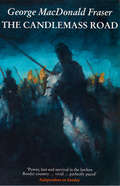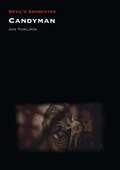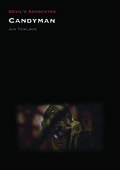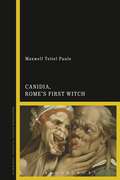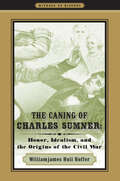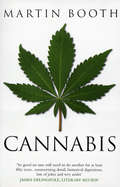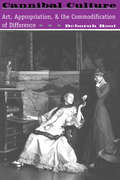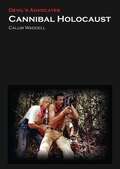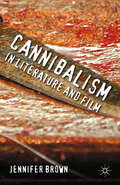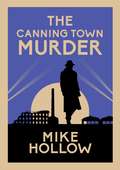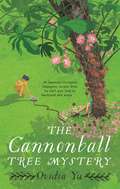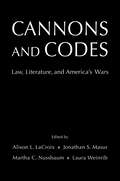- Table View
- List View
A Candlelit Regency Christmas: His Housekeeper's Christmas Wish (lords Of Disgrace, Book 1) / His Christmas Countess (lords Of Disgrace, Book 2) (Mills And Boon M&b Ser. #1)
by Louise AllenHis Housekeeper’s Christmas Wish
Candlemas: The Crackling House (1588: A Calendar of Crime)
by Shirley McKayCandlemas is the first of five new, self-contained mysteries released as eBooks throughout the year in step with the sixteenth century calendar. A complete collection will be available after the publication of the fifth story.On Candlemas eve an apprentice candle maker finds his master, John Blair dead in his workshop, and the evidence points to the surgeon Sam Sturrock. Enlisted by Sturrock's desperate apprentice, Hew Cullen, together with his friend and physician Giles Locke, finds himself drawn into the investigation to uncover the truth of the matter. At first it seems like Blair's death is the result of reckless surgical practice, but as Hew delves deeper into the life of the candle maker he discovers a web of extortion and deceit.John Blair was a man with many enemies...Look out for the other stories in the series: Whitsunday, Lammas, Martinmas and Yule.
The Candlemass Road (Magna Large Print Ser.)
by George MacDonald FraserThis is a beautiful, moving tale from the bestselling author of the "Flashman Papers".
Candyman (Devil's Advocates)
by Jon TowlsonWhen Candyman was released in 1992, Roger Ebert gave it his thumbs up, remarking that the film was “scaring him with ideas and gore, rather than just gore.” Indeed, Candyman is almost unique in 1990s horror cinema in that it tackles its sociopolitical themes head on. As critic Kirsten Moana Thompson has remarked, Candyman is "the return of the repressed as national allegory": the film’s hook-handed killer of urban legend embodies a history of racism, miscegenation, lynching, and slavery, "the taboo secrets of America’s past and present."In this book, Jon Towlson considers how Candyman might be read both as a "return of the repressed" during the George H. W. Bush era, and as an example of nineties neoconservative horror. He traces the project’s development from its origins as a Clive Barker short story ("The Forbidden"); discusses the importance of its gritty real-life Cabrini-Green setting; and analyzes the film’s appropriation (and interrogation) of urban myth. The two official sequels (Candyman: Farewell to the Flesh [1995] and Candyman: Day of the Dead [1999]) are also considered, plus a number of other urban myth-inspired horror movies such as Bloody Mary (2006) and films in the Urban Legend franchise. The book features an in-depth interview with Candyman’s writer-director Bernard Rose.
Candyman (Devil's Advocates)
by Jon TowlsonWhen Candyman was released in 1992, Roger Ebert gave it his thumbs up, remarking that the film was “scaring him with ideas and gore, rather than just gore.” Indeed, Candyman is almost unique in 1990s horror cinema in that it tackles its sociopolitical themes head on. As critic Kirsten Moana Thompson has remarked, Candyman is "the return of the repressed as national allegory": the film’s hook-handed killer of urban legend embodies a history of racism, miscegenation, lynching, and slavery, "the taboo secrets of America’s past and present."In this book, Jon Towlson considers how Candyman might be read both as a "return of the repressed" during the George H. W. Bush era, and as an example of nineties neoconservative horror. He traces the project’s development from its origins as a Clive Barker short story ("The Forbidden"); discusses the importance of its gritty real-life Cabrini-Green setting; and analyzes the film’s appropriation (and interrogation) of urban myth. The two official sequels (Candyman: Farewell to the Flesh [1995] and Candyman: Day of the Dead [1999]) are also considered, plus a number of other urban myth-inspired horror movies such as Bloody Mary (2006) and films in the Urban Legend franchise. The book features an in-depth interview with Candyman’s writer-director Bernard Rose.
Cane River (Thorndike Press Large Print Americana Ser.)
by Lalita TademySet among the plantations in deepest Louisiana, CANE RIVER follows the lives of five generations of women from the time of slavery in the early 1800s into the early years of the 20th century. From down-trodden, philosophical Suzette, who was born and died a slave, to educated, pale-skinned Emily, whose high ambitions born in freedom become her downfall, we are introduced to a remarkable cast of characters whose struggles reflect the tragedy of slavery and, ultimately, the triumph of the spirit. This deeply personal saga - based entirely on the author's research into her own family history - ranks with the best African-American novels and introduces a major new writer.
Canidia, Rome’s First Witch
by Maxwell Teitel PauleCanidia is one of the most well-attested witches in Latin literature. She appears in no fewer than six of Horace's poems, three of which she has a prominent role in. Throughout Horace's Epodes and Satires she perpetrates acts of grave desecration, kidnapping, murder, magical torture and poisoning. She invades the gardens of Horace's literary patron Maecenas, rips apart a lamb with her teeth, starves a Roman child to death, and threatens to unnaturally prolong Horace's life to keep him in a state of perpetual torment. She can be seen as an anti-muse: Horace repeatedly sets her in opposition to his literary patron, casts her as the personification of his iambic poetry, and gives her the surprising honor of concluding not only his Epodes but also his second book of Satires. This volume is the first comprehensive treatment of Canidia. It offers translations of each of the three poems which feature Canidia as a main character as well as the relevant portions from the other three poems in which Canidia plays a minor role. These translations are accompanied by extensive analysis of Canidia's part in each piece that takes into account not only the poems' literary contexts but their magico-religious details.
Canidia, Rome’s First Witch
by Maxwell Teitel PauleCanidia is one of the most well-attested witches in Latin literature. She appears in no fewer than six of Horace's poems, three of which she has a prominent role in. Throughout Horace's Epodes and Satires she perpetrates acts of grave desecration, kidnapping, murder, magical torture and poisoning. She invades the gardens of Horace's literary patron Maecenas, rips apart a lamb with her teeth, starves a Roman child to death, and threatens to unnaturally prolong Horace's life to keep him in a state of perpetual torment. She can be seen as an anti-muse: Horace repeatedly sets her in opposition to his literary patron, casts her as the personification of his iambic poetry, and gives her the surprising honor of concluding not only his Epodes but also his second book of Satires. This volume is the first comprehensive treatment of Canidia. It offers translations of each of the three poems which feature Canidia as a main character as well as the relevant portions from the other three poems in which Canidia plays a minor role. These translations are accompanied by extensive analysis of Canidia's part in each piece that takes into account not only the poems' literary contexts but their magico-religious details.
Canines in Cervantes and Velázquez: An Animal Studies Reading of Early Modern Spain
by John BeusterienThe study of the creation of canine breeds in early modern Europe, especially Spain, illustrates the different constructs against which notions of human identity were forged. This book is the first comprehensive history of early modern Spanish dogs and it evaluates how two of Spain’s most celebrated and canonical cultural figures of this period, the artist Diego Velázquez and the author Miguel de Cervantes, radically question humankind’s sixteenth-century anthropocentric self-fashioning. In general, this study illuminates how Animal Studies can offer new perspectives to understanding Hispanism, giving readers a fresh approach to the historical, literary and artistic complexity of early modern Spain.
Canines in Cervantes and Velázquez: An Animal Studies Reading of Early Modern Spain
by John BeusterienThe study of the creation of canine breeds in early modern Europe, especially Spain, illustrates the different constructs against which notions of human identity were forged. This book is the first comprehensive history of early modern Spanish dogs and it evaluates how two of Spain’s most celebrated and canonical cultural figures of this period, the artist Diego Velázquez and the author Miguel de Cervantes, radically question humankind’s sixteenth-century anthropocentric self-fashioning. In general, this study illuminates how Animal Studies can offer new perspectives to understanding Hispanism, giving readers a fresh approach to the historical, literary and artistic complexity of early modern Spain.
The Caning of Charles Sumner: Honor, Idealism, and the Origins of the Civil War (Witness to History)
by Williamjames Hull HofferA signal, violent event in the history of the United States Congress, the caning of Charles Sumner on the Senate floor embodied the complex North-South cultural divide of the mid-nineteenth century. Williamjames Hull Hoffer's vivid account of the brutal act demonstrates just how far the sections had drifted apart and explains why the coming war was so difficult to avoid. Sumner, a noted abolitionist and gifted speaker, was seated at his Senate desk on May 22, 1856, when Democratic Congressman Preston S. Brooks approached, pulled out a gutta-percha walking stick, and struck him on the head. Brooks continued to beat the stunned Sumner, forcing him to the ground and repeatedly striking him even as the cane shattered. He then pursued the bloodied, staggering Republican senator up the Senate aisle until Sumner collapsed at the feet of Congressman Edwin B. Morgan. Colleagues of the two intervened only after Brooks appeared intent on beating the unconscious Sumner severely—and, perhaps, to death. Sumner's crime? Speaking passionately about the evils of slavery, which dishonored both the South and Brooks’s relative, Senator Andrew P. Butler. Celebrated in the South for the act, Brooks was fined only three hundred dollars, dying a year later of a throat infection. Sumner recovered and served out a distinguished Senate career until his death in 1873.Hoffer's narrative recounts the caning and its aftermath, explores the depths of the differences between free and slave states in 1856, and explains the workings of the Southern honor culture as opposed to Yankee idealism. Hoffer helps us understand why Brooks would take such great offense at a political speech and why he chose a cane—instead of dueling with pistols or swords—to meet his obligation under the South’s prevailing code of honor. He discusses why the courts meted out a comparatively light sentence. He addresses the importance of the event in the national crisis and shows why such actions are not quite as alien to today’s politics as they might at first seem.
Canna: The Story of a Hebridean Island
by Dr John Lorne CampbellThis is the definitive history of Canna, one of the most beautiful of all the Scottish islands. Fertile and with a sheltered harbour, Canna has played an important part in the story of the Hebrides. After the Reformation the island was of considerable importance to the Irish Franciscan mission of the 1620s and also the Jacobite risings before it was swept up in the tragedies of depopulation and clearances of the nineteenth century. Gifted to the National Trust in 1981, the island is currently undergoing something of a revival, with the creation of the St Edward Centre on Sanday, and the proposed developments of Canna House. Recent archaeological surveys and historical research has uncovered much new evidence about the island. Hugh Cheape of the Royal Museum of Scotland, who has been intimately involved in the Canna project, has fully edited the book. New contributions both update and fill out the account of the island.
Cannabis: A History
by Martin BoothTo some it's antisocial anathema, to others it is a harmless way to relax, or provides relief from crippling pain. Some fear it is a dangerous drug that leads to 'reefer madness' and addiction; to others still it is a legal anomaly and should be decriminalized. Whatever the viewpoint, and by whatever name it is known, cannabis - or marijuana, hashish, pot, dope, kif, weed, dagga, grass, ganja - incites debate at every level. In this definitive study, Martin Booth - author of the acclaimed OPIUM: A HISTORY - charts the history of cannabis from the Neolithic period to the present day. It is a fascinating, colourful tale of medical advance, religious enlightenment, political subterfuge and human rights; of law enforcement and customs officers, smugglers, street pushers, gang warfare, writers, artists, musicians, hippies and pot-heads.Booth chronicles the remarkable and often mystifying process through which cannabis, a relatively harmless substance, became outlawed throughout the Western world, and the devastating effect such legislation has had on the global economy. Above all, he demonstrates how the case for decriminalization remains one of the twenty-first century's hottest topics.
Cannae: The Experience of Battle in the Second Punic War
by Gregory DalyOn a hot and dusty summer's day in 216 BC, the forces of the Carthaginian general Hannibal faced the Roman army in a dramatic encounter at Cannae. Massively outnumbered, the Carthaginians nevertheless won an astonishing victory - one that left more than 50,000 men dead.Gregory Daly's enthralling study considers the reasons that led the two armies to the field of battle, and why each followed the course that they did when they got there. It explores in detail the composition of the armies, and the tactics and leadership methods of the opposing generals. Finally, by focusing on the experiences of those who fought, Daly gives an unparalleled portrait of the true horror and chaos of ancient warfare.This striking and vivid account is the fullest yet of the bloodiest battle in ancient history.
Cannae: The Experience of Battle in the Second Punic War
by Gregory DalyOn a hot and dusty summer's day in 216 BC, the forces of the Carthaginian general Hannibal faced the Roman army in a dramatic encounter at Cannae. Massively outnumbered, the Carthaginians nevertheless won an astonishing victory - one that left more than 50,000 men dead.Gregory Daly's enthralling study considers the reasons that led the two armies to the field of battle, and why each followed the course that they did when they got there. It explores in detail the composition of the armies, and the tactics and leadership methods of the opposing generals. Finally, by focusing on the experiences of those who fought, Daly gives an unparalleled portrait of the true horror and chaos of ancient warfare.This striking and vivid account is the fullest yet of the bloodiest battle in ancient history.
Cannibal Culture: Art, Appropriation, And The Commodification Of Difference
by Deborah RootThe book examines the ways Western art and Western commerce co-opt, pigeonhole, and commodify so-called "native experiences." It raises important and uncomfortable questions about how we travel, what we buy, and how we determine cultural merit.
Cannibal Encounters: Europeans and Island Caribs, 1492–1763 (Johns Hopkins Studies in Atlantic History and Culture)
by Philip P. BoucherPhilip Boucher analyzes the images—and the realities—of European relations with the people known as Island Caribs during the first three centuries after Columbus. Based on literary sources, travelers' observations, and missionary accounts, as well as on French and English colonial archives and administrative correspondence, Cannibal Encounters offers a vivid portrait of a troubled chapter in the history of European-Amerindian relations.
Cannibal Holocaust (Devil's Advocates)
by Calum WaddellCannibal Holocaust is one of the most controversial horror films ever made. Despite not achieving huge success when it was first released, the Italian production found an audience on home video in the 1980s and became a 'must-see' for connoisseurs of extreme cinema. Indeed, Cannibal Holocaust's foremost legacy is in the United Kingdom, where it obtained its reputation as one of the most harrowing and offensive 'video nasties' – a term used to refer to a group of films deemed to be 'obscene' by the Department of Public Prosecutions. However, as the years have progressed, Cannibal Holocaust has been re-evaluated, mainly as the forefather of the 'found footage' film, and recent home video re-releases have added some valuable perspective to the onscreen violence with extensive cast and crew interviews. What is missing from this contemporary activity is contextualization of Cannibal Holocaust's style, affirmation and discussion of its locations and any extensive discourse about its representation of third world inhabitants (i.e. as 'primitives'). In addition, and also amiss from previous dialogue on the production, is that Cannibal Holocaust can be seen as one of the key post-Vietnam films. It is the spectre of war – and an explicit warning about Western involvement in civil conflict – which progresses Deodato's story of jungle adventurers in peril. By approaching the film from a more formalist position, this Devil's Advocate provides an insightful discussion of this groundbreaking film.
Cannibal Island: Death in a Siberian Gulag (Human Rights and Crimes against Humanity #2)
by Nicolas WerthA searing historical account of a tragic episode of the Stalinist terrorDuring the spring of 1933, Stalin&’s police rounded up nearly one hundred thousand people as part of the Soviet regime&’s &“cleansing&” of Moscow and Leningrad and deported them to Siberia. Many of the victims were sent to labor camps, but ten thousand of them were dumped in a remote wasteland and left to fend for themselves. Cannibal Island reveals the shocking, grisly truth about their fate.These people were abandoned on the island of Nazino without food or shelter. Left there to starve and to die, they eventually began to eat each other. Nicolas Werth, a French historian of the Soviet era, reconstructs their gruesome final days using rare archival material from deep inside the Stalinist vaults. Werth skillfully weaves this episode into a broader story about the Soviet frenzy in the 1930s to purge society of all those deemed to be unfit. For Stalin, these undesirables included criminals, opponents of forced collectivization, vagabonds, gypsies, even entire groups in Soviet society such as the &“kulaks&” and their families. Werth sets his story within the broader social and political context of the period, giving us for the first time a full picture of how Stalin&’s system of &“special villages&” worked, how hundreds of thousands of Soviet citizens were moved about the country in wholesale mass transportations, and how this savage bureaucratic machinery functioned on the local, regional, and state levels.Cannibal Island challenges us to confront unpleasant facts not only about Stalin&’s punitive social controls and his failed Soviet utopia but about every generation&’s capacity for brutality—including our own.
Cannibalism in High Medieval English Literature (The New Middle Ages)
by H. BlurtonThis book reads the surprisingly widespread representations of cannibals and cannibalism in medieval English literature as political metaphors that were central to England's on-going process of articulating cultural and national identity.
Cannibalism in Literature and Film
by J. BrownA comprehensive study of cannibalism in literature and film, spanning colonial fiction, Gothic texts and contemporary American horror. Amidst the sharp teeth and horrific appetite of the cannibal, this book examines real fears of over-consumerism and consumption that trouble an ever-growing modern world.
Cannibals and Carnage: Thrilling Tales of the Sea (vol.1) (Thrilling Tales of the Sea #1)
by Graham FaiellaIn the nineteenth century true stories of cannibal tribes massacring white traders (and vice versa) and missionaries fed the morbid appetites of Europeans, North Americans and colonials. Accounts of cannibalism committed by seafarers on their dead shipmates quickened the pulses of landfolk even more, and pricked their moral disquiet. Acts of desperate men committing unspeakable atrocities. The warring frenzy of cannibal headhunters and their gruesome feasting. Such was the stuff of real-life ‘sixpenny romances’, rich in human butchery and garnished with treachery and terror. The more atrocious the at rocities, the more exotic the locations; the more sensational the narratives, the greater was the thrall of these thrilling tales of the sea.
The Canning Town Murder: The intriguing wartime murder mystery (Blitz Detective #2)
by Mike HollowSeptember, 1940. As the Blitz takes its nightly toll on London and Hitler prepares his invasion fleet just across the Channel in occupied France, Britain is full of talk about enemy agents. Suspicion is at an all time high and no one is sure who can be trusted.In Canning Town, rescue workers are unsettled when they return to a damaged street and discover a body that shouldn’t be there. When closer examination of the corpse reveals death by strangling, Detective Inspector John Jago is called upon to investigate. But few seem to really care about the woman’s death – not even her family. As Jago digs deeper he starts to uncover a trail of deception, betrayal, and romantic entanglements…
The Cannonball Tree Mystery: From the CWA Historical Dagger Shortlisted author comes an exciting new historical crime novel
by Ovidia Yu'One of Singapore's finest living authors' South China Morning Post'Simply glorious. Every nook and cranny of 1930s Singapore is brought richly to life' CATRIONA MCPHERSON'Charming' RHYS BOWEN'One of the most likeable heroines in modern literature' SCOTSMAN ________________Has Su Lin summoned a tree demon who is now killing on her behalf?The overpoweringly fragrant flowers, snakelike vines and deadly fruit of the cannonball tree are enough to keep most people away. But when a piece of expensive photographic equipment is found nearby, on closer inspection Su Lin discovers the body of Mimi, her horrible relative who has been trying to blackmail her.Su Lin is not the only one to realise how much easier this death makes things for her in the new normal of life in Syonan (Japanese Occupied Singapore). And then more fortuitious deaths follow. But is someone really killing people on her account? As Su Lin contends with the fear and rancour of those around her, the resentment of former friends and a whistling demon, can she hope not only to survive but untangle the cannonball tree's secrets to prevent further deaths... and possibly turn the tide of the war?________________Praise for Ovidia Yu:'Chen Su Lin is a true gem. Her slyly witty voice and her admirable, sometimes heartbreaking, practicality make her the most beguiling narrator heroine I've met in a long while' Catriona McPherson'Charming and fascinating with great authentic feel. Ovidia Yu's teenage Chinese sleuth gives us an insight into a very different culture and time. This book is exactly why I love historical novels' Rhys Bowen'A wonderful detective novel . . . a book that introduces one of the most likeable heroines in modern literature and should be on everyone's Must Read list' Scotsman'Unassuming, brilliantly observant' SCMP'Ovidia Yu's writing helped me peel back the layers to understand Singapore. The story and Chen Su Lin's initiative and tenacity, set against a backdrop of wartime Singapore, intrigued both the historian and the mystery lover in me' Kara Owens CMG CVO, British High Commissioner to Singapore
Cannons and Codes: Law, Literature, and America's Wars
by Alison L. Lacroix, Jonathan S. Masur, Martha C. Nussbaum, Laura WeinribIt can be said that western literature begins with a war story, the Iliad; and that this is true too of many non-Western literary traditions, such as the Mahabharata. And yet, though a profoundly human subject, war often appears to be by definition outside the realm of structures such as law and literature. When we speak of war, we often understand it as incapable of being rendered into rules or words. Lawyers struggle to fit the horrors of the battlefield, the torture chamber, or the makeshift hospital filled with wounded and dying civilians into the framework of legible rules and shared understandings that law assumes and demands. In the West's centuries-long effort to construct a formal law of war, the imperative has been to acknowledge the inhumanity of war while resisting the conclusion that it need therefore be without law. Writers, in contrast, seek to find the human within war--an individual story, perhaps even a moment of comprehension. Law and literature might in this way be said to share imperialist tendencies where war is concerned: toward extending their dominion to contain what might be uncontainable. Law, literature, and war are thus all profoundly connected--and it is this connection this edited volume aims to explore, assembling essays by preeminent scholars to discuss the ways in which literary works can shed light on legal thinking about war, and how a deep understanding of law can lead to interpretive insights on literary works. Some of the contributions concern the lives of soldiers; others focus on civilians living in war zones who are caught up in the conflict; still others address themselves to the home front, far from the theatre of war. By collecting such diverse perspectives, the volume aims to illuminate how literature has reflected the totalizing nature of war and the ways in which it distorts law across domains.


